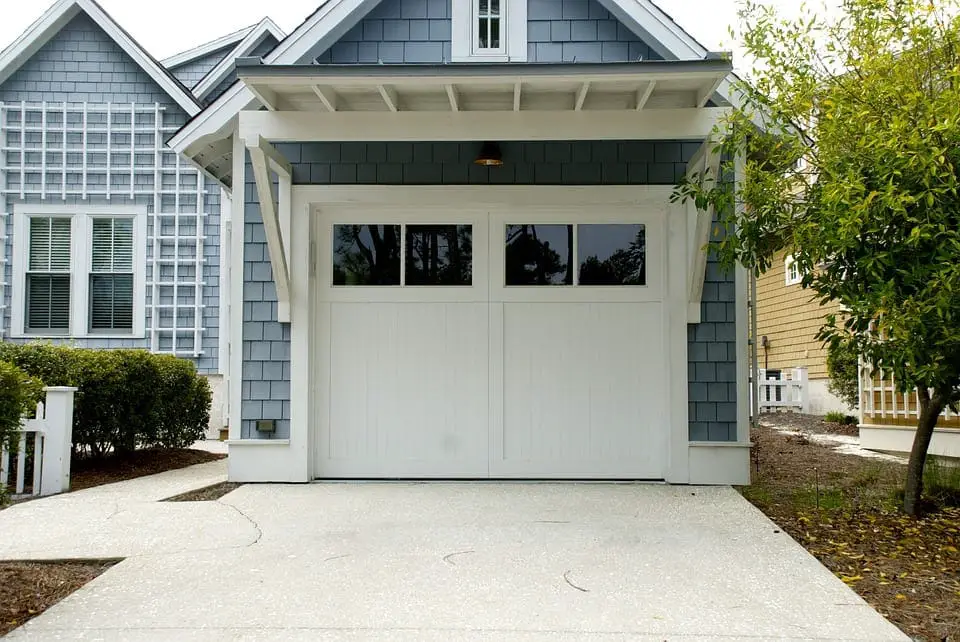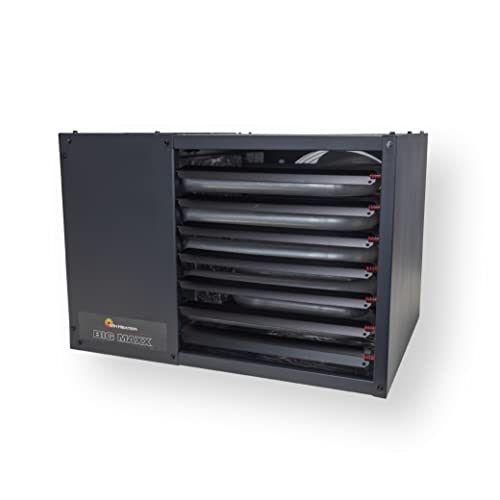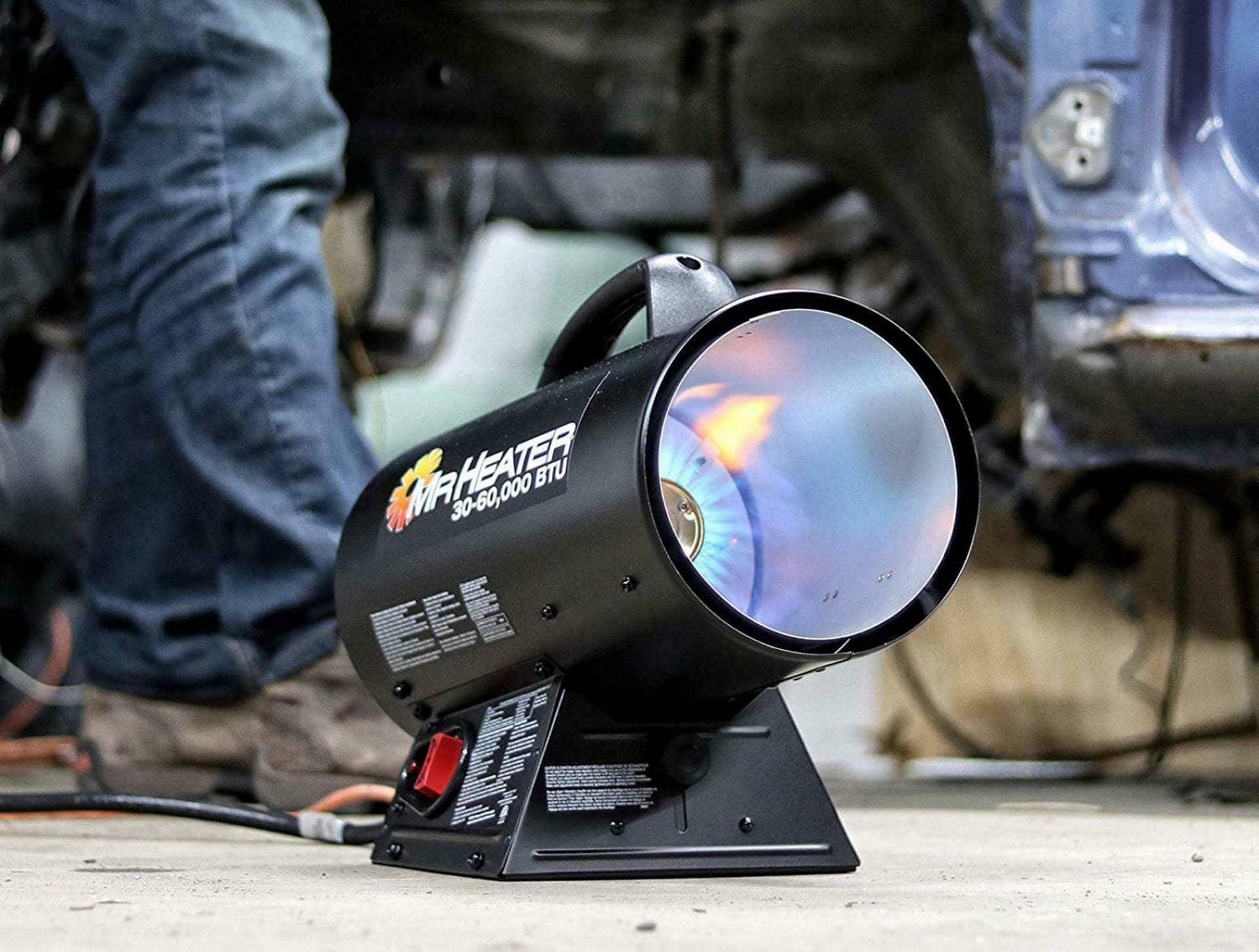Propane heaters are particularly effective at heating garages. As garages are usually drafty places, it is important to have a powerful heater to provide the needed warmth. Electric is commonly used for this. However electric heaters tend not to be so effective, requiring a lot of electricity to generate enough warmth, making them costly. Propane is far more cost-effective.
People often wonder if it is safe to use a propane heater in a garage. While it is safe, there are a few things to consider so that you use your heater correctly. There must be enough oxygen, which is usually not an issue in a drafty garage. Without enough oxygen, the poor combustion can cause carbon monoxide to form. Garages are actually a great environment to avoid this. Equally, make sure your heater is away from anything flammable, and that there is nothing cluttering the heater.
If your garage is poorly ventilated, a propane heater is perhaps not for you.
Comparison of the Best Propane Garage Heaters
| IMAGE | PRODUCT | |
|---|---|---|
Our Top Pick  |
| View Latest Price → |
 |
| View Latest Price → |
 |
| View Latest Price → |
 |
| View Latest Price → |
What to Consider Before Buying a Propane Garage Heater
Portability
If you are looking to move your heater around, you need to consider how portable the heater is. Some models come equipped with ergonomic carry handles and lightweight designs to make lifting easier.
Other, usually larger models can also be found with wheels. Try to look for reviews that highlight durability if being transported frequently in a car or truck.
Installation
If you’re choosing a model that isn’t portable and needs to be installed, consider where you will place the heater. Measure this space to find a heater that fits. While ensuring that it can structurally hold the weight. Lightweight designs with easy installation are best, or you will need to hire an installer, adding to the cost.
Size and Power
Consider the size of the space that needs heating. Garages are large as well as drafty, so you’ll need to consider that when a heater might say it heats 1000 square feet. Hot air is lost more easily in a garage. You will need something with slightly higher power and efficiency than you would for a regular, insulated interior room. While still being able to fit it into the area you have for it.

Cost
Not only do you want your product to cost less, but you also want it to be cost-effective. This means that you need to consider the running costs and thinking about the initial price.
When it comes to garage heaters, well-insulated and well-vented garages will be better served, with lower running costs. Equally, a heater that can cope with your needs without over-performing will run at a lower cost. Make sure you measure effectively and calculate the power you need. And search for a product in your price range that meets that.
Features
Technological advancements have brought an array of added extras. Integrated thermostats will allow you to set an even temperature for your room. While automatic ignitions are far more convenient.
You may want remote control or to have specific settings. Or maybe you are keen for a digital display. There are all manners of features to improve operation and convenience.
Safety
Look for models that have tip-over protection to make the user aware if the heater is falling over. Equally, overheat protection will prevent the device from overheating. Look for heaters that incorporate carbon monoxide safety measures as well.

Propane Heaters vs. Electric Heaters
Propane is cheaper to use than electric, making electric heaters more costly to run. In fact, propane can cut down energy costs by a third. With this in mind, propane can get hotter than electric, heating rooms far more quickly; also reducing the costs.
Propane products tend to have a longer lifespan than electric products. They are more durable, and the clean fuel prevents the components from breaking down, increasing longevity. That said, electric heaters are usually cheaper up front.
Electric heaters tend to be silent. Whereas propane heaters are a little noisy, which makes them less suitable in the bedroom. However, electric heaters that have a fan can also make a mechanical sound.
For those who live in areas with unreliable electricity, electric heaters won’t be able to cope in the stormier, colder months. Propane tanks can be stored safely in your garage, serving as a heat source even if the grid goes down. This is equally true for people who don’t have electricity run to their garage. Instead, propane tanks can be easily installed, and the garage can be heated without installing cables.
If it gets particularly gusty in your garage, the wind could blow out the flame for the propane, making it harder to light. Electric heaters are slightly easier to get going.
At a Glance: Our Top Picks for Propane Heaters For Garage
- OUR TOP PICK: Mr. Heater Corporation Convection Heater, 25,000 BTU/HR
- EDITOR'S PICK: Avenger FBDFA60V Portable Forced Air Propane Heater, 60000 Btu
- BEST VENTLESS PROPANE GARAGE HEATER: Mr. Heater F274800 MH18B
Reviews of the Best Propane Garage Heaters
Take a look at these reviews below to get to grips with some of the best propane heaters for a garage installation. Available on the market today, these models give a large display of options for all price ranges.
Best Overall
Mr. Heater Corporation Convection Heater, 25,000 BTU/HR

Specifications
Coverage Area (sq ft): 625
Power (watts): N/A
Dimensions: 13.0×13.0x14.0″
Weight: 4 pounds
We may earn commission from purchases made from our links, at no additional cost to you
Review
Operating for 17 hours on a 2lb tank of propane, this heater gives out 25,000 BTU of heat, while heating 625 square feet. All gas fixtures are included, and a standing pilot is installed to increase the safety.
This heater is most suitable for smaller garages that have a lot of ventilation. They are easy to light and the low fuel usage means they don’t need to be refueled so often.
Pros
This is a long-lasting heater for small spaces
This model is very fuel efficient, lowering running costs
There is a Piezo push-button igniter for much easier starting
Propane tank installation is incredibly easy, with simple instructions, and all fittings included
Cons
It lets off a strange metallic burning smell when first used
This device does not include any safety features beyond the standing pilot
Editor’s Pick
Avenger FBDFA60V Portable Forced Air Propane Heater, 60,000 BTU

Specifications
Coverage Area (sq ft): 1,450
Power (watts): N/A
Dimensions: 17.0×10.x15.5″
Weight: 16 pounds
We may earn commission from purchases made from our links, at no additional cost to you
Review
This portable forced air heater has 60,000 BTU of heat output. It has a durable black coating and is made of sturdy parts. The heater angle can be adjusted, and the push-button start makes for easy ignition. It has a big carry handle and is relatively lightweight.
This simple heater is durable and has a long lifespan, and is easy to use from the get-go. It can be moved around without hassle but doesn’t have safety mechanisms to alert you if it falls over.
Pros
It is easy to transport using the carry handle
The motor is thermally-protected, increasing its longevity
This device comes all put together, and there is no need for installation
It has been certified to be safe to use on combustible flooring, making is safer for use in garages
Cons
There is no tip-over or overheat protection
This model isn’t the most effective in very cold environments
Best Ventless Propane Garage Heater
Mr. Heater F274800 MH18B

Specifications
Coverage Area (sq ft): 450
Power (watts): N/A
Dimensions: 18.5x18x11.4″
Weight: 2.75 pounds
We may earn commission from purchases made from our links, at no additional cost to you
What Recent Buyers Report
This product has proved itself to be trustworthy to both old and new customers. The safety precautions and the durability of this heater are unusual. It is a very popular appliance in the North-American region due to its high efficiency and reliability. Nearly 80% of customers define it as a five-star product.
Why it Stands Out to Us
The high efficiency of this product and excellent customer reviews have added a lot to its popularity since its release in the market. One of the excellent features of this device includes its safety precautions that include auto shut-off whenever it is tipped over or detects low oxygen levels.
Bottom Line
Overall, this is a sturdy and easy-to-use device that comes with all the necessary safety features. It has nearly 100% efficiency, which makes its operation price quite cheap. In short, it is one of the best garage heaters currently available.
Pros
Nearly 100% efficient and ventless
Covers area as large as 450 square feet
High safety precautions, such as auto turn-off
A clean source of heat with no harmful by-products
Works between 4,000 and 18,000-BTUs and approved for indoor use
Cons
May stop working at higher altitudes with low oxygen levels
Best Vented Propane Garage Heater
Mr. Heater F260560 Big Maxx MHU80NG

Specifications
Coverage Area (sq ft): 2000
Power (watts): N/A
Dimensions: 30.31×27.55×22.04″
Weight: 88.2 pounds
We may earn commission from purchases made from our links, at no additional cost to you
What Recent Buyers Report
Customers refer to the build of this product as extraordinary. The credit goes to the excellent design and durable materials used in manufacturing. Installation is quite easy and quick. This heater produces a lot of heat with adequate fuel consumption and is preferable for icy areas.
Why it Stands Out to Us
It is a heavy-duty heater that can maintain the temperature to a suitable warmth, even in freezing conditions. The powered exhaust system allows the fitting to be horizontal or vertical as suitable for customer’s needs. The fuel consumption compared to the heat production is exemplary.
Bottom Line
In all, this device is ideal for cold places where conventional heating systems are not very usable. Combined with efficiency and the cheap operational cost, this product is safe, cheap, and silent heating.
Pros
High performance around 80,000 BTUs
Covers a large area of 2000 square feet
Equipped with a self-diagnostic control module
Warranty of three years of burners and different parts
Powered exhausts that can be vertically or horizontally adjusted
Works even with the input of natural gas as well as liquid propane
Cons
Thermostat, hose, and regulator are separately sold
Eight-feet of ground clearance required minimally from the floor to the base of the unit
Mr. Heater MH60QFAV 60,000 BTU Portable Propane Forced Air Heater

Specifications
Coverage Area (sq ft): 1500
Power (watts): N/A
Dimensions: 15.98×8.82×13.5″
Weight: 13.01 pounds
We may earn commission from purchases made from our links, at no additional cost to you
Review
With 60,000 BTU of heat output, this model can war up to 1500 square feet. With variable heat settings from 30,000 to 60,000 BTU, this model device can run up to 14 hours without refueling. The QBT technology makes it 50% quieter than similar heaters.
A good heater for construction work, this device is made from durable materials. It heats a garage quickly with its high-powered fan, but it doesn’t have a thermostat to keep the temperature even.
Pros
The high output fan forces air around, heating the garage quickly and evenly
This model operates more quietly, not disturbing the workspace of the garage
This heater is designed to be rugged, with its durability making it great for construction sites
The variable heat settings allow you to set a more comfortable environment and create versatility
Cons
The cord is very short, making it difficult to place
There is no thermostat, and none can be installed with this model
Comparison Overview
The two popular choices for customers are kerosene and propane garage heaters. Let’s compare the working efficiency, cost, and safety of these products.
Propane vs. Kerosene Garage Heater
A brief contrast of these products is given below.
Safety and Health
The combustion of propane gas is of zero significance because it is considered as a source of clean energy, so the emission rate of a propane heater is nearly zero.
On the other hand, the combustion of kerosene leads to a large number of toxic gases and fine soot particles. Some of the gases produced are Carbon Monoxide, Sulphur Dioxide, and Sulphur Monoxide. This can pose serious health issues.
Cost and Efficiency
Kerosene is known to produce more heat while burning than propane, but the latter is much cheaper and accessible to acquire. The efficiency of kerosene heaters is very less significant when the prices for the fuels are compared.
Time of Use
If you need to use your heater for a short time, then an immediate source will be required; in that case, kerosene heaters will be preferable while if you need continuous warmth and need to keep the heater running, then propane heaters are ideal.

How to Install a Propane Garage Heater
The installation of a garage heater isn’t really difficult and involves the following easy steps:
- In the first step, attach the heater’s input to the external source of the propane, such as a cylinder or any other vessel. The pipe to attach the cylinder is given in the assembly tool kit.
- You may need some tools to tighten both the ends of the pipe. Tighten the bolts at both ends using a wrench or any other fitting tool.
- Check for any leaks or loose bolts before using this apparatus at all times.
- Check the proper functioning of the pilot flame to prevent any emergency conditions and the loss of gas due to poor ignition.
- Open the valve from the cylinder to allow the flow of propane into the heater.
- Rotate the knob from pilot mode to the next heating point per your needs after the heater is lighted up.
That’s about it!
Conclusion
Propane heaters can be a wise choice for a garage. With the power to deal with the drafty environment, propane heaters cope easily with heating garages. Choosing radiant or convective heat is up to you, as it is the portability of your propane heater.
Always try to think of what you need to fit it into your space physically, as well as how it will be used in your life. This way you will find a product that meets all your requirements, within your budget.
People Also Ask
If you own a large garage, you can greatly benefit from a propane heater. However, before you can finalize your purchase, you might still have questions. Here are some common questions that might help you find the answer you are looking for too.
To clean a propane garage heater, remove the cylinder and note that no gas leak should be present. Try to vacuum off most of the debris and then clean using a brush gently. Remove the parts of the heater one by one and repeat the previous steps. Put the parts together as described in the manual and turn it on to ensure proper functioning.
There are different models of propane garage heaters. Some of them require venting, while others do not. Nonetheless, propane is considered to be a clean source of energy.
It depends on the care taken of the product and the time for which it is used. Propane garage heaters can last from six years to a life-time only if they are maintained and taken care of properly. Cleaning the heater at regular intervals and using proper fuel is vital for extended life.
Yes, it’s possible to use a propane heater in your garage. However, taking care of two things is essential. Firstly, there must be adequate air for operation, and secondly, it should be kept away from all flammable materials.
Forced-air heaters like propane with 45,000 BTU are enough for heating a two-car garage. Meanwhile, if you have an infrared heater, then for a two-car garage, 30,000 BTUs are enough.
To find the perfect place for your garage heater, keep the following in mind:
1. Find the coldest corner of the garage. You can use thermometers to do so.
2. Angle your heater such that it blows air towards the center of the door, leaving a minimum of 4 inches between the sides of the walls and the heater.
3. Keep all flammable materials 3 feet away from the heater’s front.
